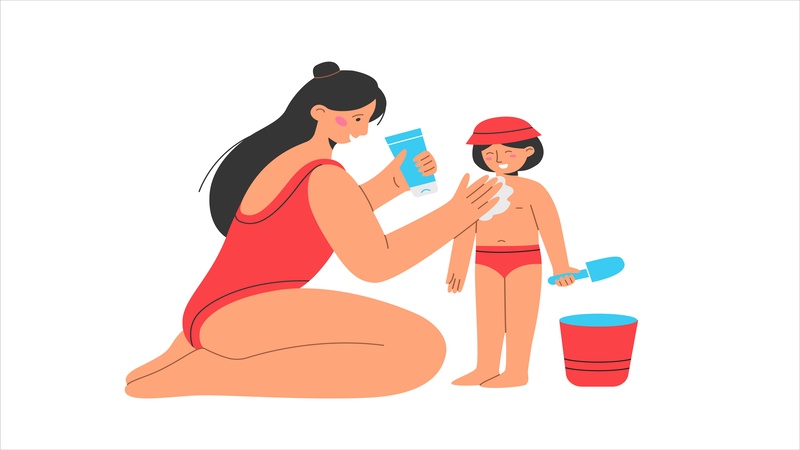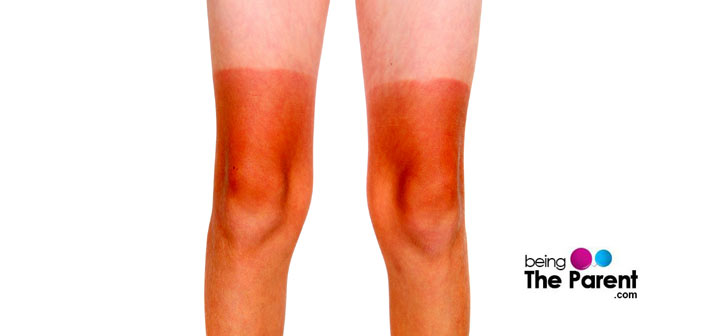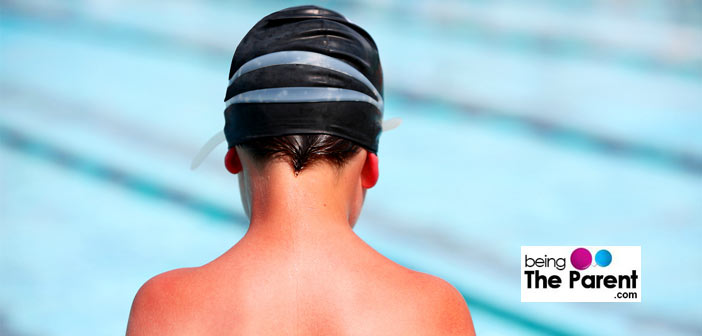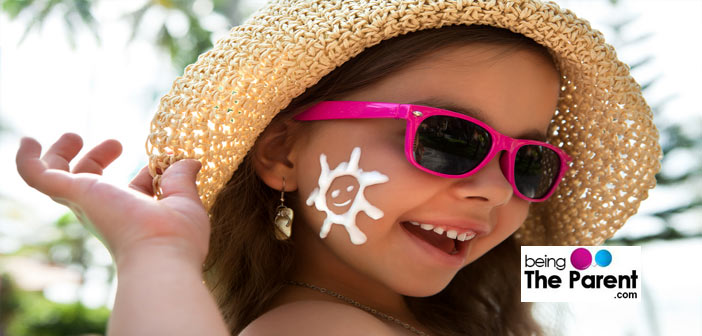
Exposure to the sun is the top source through which we can get vitamin D in our bodies. Vitamin D is essential for us to absorb calcium in the body to have healthy bones and teeth. However, repeated and prolonged exposure to the sun can also be a cause of worry and damage to our bodies. The harmful UV rays from the sun can even cause skin cancer,
However, the skin of our children is far more delicate than ours and sensitive too. Small amount of sun exposure works wonder, but care should be taken with babies. Babies should not be directly exposed to sunlight.
Why Are Sun Rays Harmful For Your Child?
Sun rays essentially consist of three types of ultra violet rays – namely UVA, UVB, and UVC. All UV rays are harmful and cause damage to human body and skin. Just a few serious sunburns can increase your child’s risk of skin cancer later in life. Their skin needs protection from the sun’s harmful ultraviolet (UV) rays whenever they’re outdoors, says the CDC.GOV website.
- UVA Rays: We are most exposed to UVA rays, as they pass through the ozone layer and can cause ageing of the skin and also make your prone to early wrinkling
- UVB Rays: These rays cause sunburns, affect the immune system and the eyes, and also contribute to skin cancer. Severe UVB burns that occur before the age of 20 and can cause severe damage
- UVC Rays: These are the most dangerous rays, but fortunately are blocked by the ozone layer and do not reach the earth
It is hence, very important to protect the kids as well as yourself from the UVA and UVB sun rays.
Who Is At Risk Of Skin Damage From Sun Exposure?
Kids who are:
- fair skinned
- have light eyes, particularly green or blue
- have freckles or moles
- light haired, such as blonde or light brown
are more prone to sun damage.
Dark skinned kids will get more tanned – and tanning is a sign of sun damage. Painful sunburns are also experienced by dark-skinned kids who are exposed to sun.
Even if your kid doesn’t depict above characteristics, he is exposed to following risks.

Harmful Effects Of Sun Exposure On Kids
- Sunburn: This is the immediate sign of skin damage. Although temporary, it may lead to skin cancer in the long run. What may initially just appear to be redness, can later develop into flaky skin, pain and discomfort. Other symptoms include, headache, nausea, dizziness, feeling weak, feeling warm and even fever. Sometimes skin blisters may develop blisters, which can be extremely painful. It’s best to consult a pediatrician since they can recommend ointments/creams which are kids-friendly
- Eye damage: The eyelids are the most thinnest skin on our body. Their function is to protect eyes. Any cancer does not develops overnight, it is a slow, progressive and fatal disease. Every time the eyes are exposed to sun, they are damaged. The thin protective layer of the eye – cornea gets damaged and irritated. Common symptoms include photo sensitivity (sensitivity to light), red streaky eyes, dryness, itching and blind spots. Always wear UV protecting sunglasses and wide brimmed hats. Teach you kid never to see directly at the sun
- Melasma: Melasma is unwanted pigmented patch on the skin. It may be a discolored, brown, blue or gray colored defined spot. It is mostly incident on cheeks, forehead, neck and arms. Sometimes it may be difficult to distinguish between sunburn and melasma. Do not self-administer any creams/ointments, it’s best to take your child to the pediatrician or dermatologist. Melasma is very difficult to treat and may not ever disappear. So hopefully you do not want your kids to grow up and blame you for their spotted faces!
- Skin Cancer: The skin is made up of multiple layers and body produced melanin to protect skin against harmful skin rays. However, too much sun exposure can cause mutation (change) in this function and lead to abnormal clustering of cells. This is called skin cancer. People as young as in early 20’s are now reporting incidences of skin cancer. Frequent exposure to UV rays have been identified as the major contributor of skin cancer. If you identify any changes in the skin of your child, or maybe new moles or plenty of freckles, it’s time to consult an expert
- Suppresses immunity: Increased exposure to harmful UV rays alters the way the antibodies of our system fight against foreign bodies/infections. Harmful sun rays may damage or even kill Langerhans cells (those that fight against foreign bodies trying to enter skin and internal infections)
In addition to this, sun exposure damages tissues causing premature ageing and dullness of skin.

Symptoms of Sun Damage
- Reddish, pink skin
- Chapped lips
- Dark spots
- Dark circles under eyes
- Dry skin
- Irritated skin
- Freckles
- peeling skin
Protective Measures To Keep Kids Sun-Safe
- Cover up: Using clothes as sunblock is the best way of sun protection. Dress your kid in full sleeves, airy, light colored clothes. Slide your hand under the clothes and if you cannot see it through the clothes, the clothes will act as a protective shield against the sun. Infants, however, must not be exposed to the sun as their skin is thin and it burns more easily than that of older kids. If you must step in the sun, create shade by using an umbrella. A bit of sunscreen can also help
- Sunglasses: They not only look stylish, but go a great way of protecting eyes. However, but the ones that provide 100% UV cover, and if your kids resist wearing, let them choose and pick a pair for themselves
- Sunscreen: Preferably SPF 15+ should be applied on all exposed areas of the body. Its important to note that sunscreen must be applied repeatedly for optimum protection.Ears, and parts behind the neck and feet must not be ignored. Also, if your child is playing in the water, do use a water resistant sunscreen
- Set up shade: If your house doesn’t has abundant shadow of trees, you may want to prop up tents, or cover the verandah with Green shade cloth to create shaded play area for your kids
- Play Schedule: Restrict your child’s outing from 10:00 am to 16:00 hrs. These are the peak sun hours during summers and UV rays are most damaging during this period
- Wear Hats: Hats that cover up ears and provide shade to the face, neck, scalp are easy to use and often comes in trendy colors. Such hats can be used for great protection against the sun, and the areas not shaded by the hat can be dabbed with a sunscreen
- Keep a summer first aid box handy: Mishaps are likely to happen when kids are around. Keeping a handy first aid box would be idel when you go out for a summer picnic or take a swim in the pool

A healthy sun exposure is the key to be sun smart. Totally missing sun is not advisable. Vitamin D, synthesized from sun is important for healthy development of bones. You may obtain it from early morning or late evening walk and other outdoor activities. Protect your kids from sun now to prevent skin cancer in later life.

